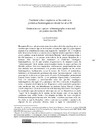Identificador persistente para citar o vincular este elemento:
http://hdl.handle.net/10553/72826
| Campo DC | Valor | idioma |
|---|---|---|
| dc.contributor.author | Santana Pérez, Juan Manuel | en_US |
| dc.contributor.author | Sanmartín, Israel | en_US |
| dc.date.accessioned | 2020-05-29T15:43:57Z | - |
| dc.date.available | 2020-05-29T15:43:57Z | - |
| dc.date.issued | 2020 | en_US |
| dc.identifier.issn | 0718-5049 | en_US |
| dc.identifier.uri | http://hdl.handle.net/10553/72826 | - |
| dc.description.abstract | En este trabajo examinamos la escritura de la historia después de los cambios que tuvieron lugar en la disciplina a finales del siglo XX, y que algunos especialistas consideraron como una especie de “secuestro” de la disciplina. Esta situación se debió a la circulación de algunos relatos importados desde la ciencia política, como la tesis de “el fin de la Historia”, las discusiones sobre el fin del marxismo, o los propios enterradores de la propia disciplina de la historia. Esta situación hizo tambalear los diferentes paradigmas historiográficos, con lo que muchos diagnosticaron la situación como de “arrumbamiento” de la historia como disciplina frente a la ciencia política o la filosofía política. Con este diagnóstico, analizaremos geográficamente cómo han afectado esas circunstancias a la práctica historiográfica en los centros historiográficos tradicionales, como la escuela de Annales, el materialismo histórico, y al denominado genéricamente como “posmodernismo”. Estos tres paradigmas conforman en gran parte el centro historiográfico perteneciente Francia, Reino Unido y EE.UU. y sus periferias dependientes y colonizadas. Una vez estudiados y sistematizados estos tres grandes paradigmas historiográficos del siglo XX y principios del XXI, y testeado el diagnóstico sobre la situación de la historia, nos dirigiremos a otras realidades geográficas más periféricas. Así, nos detendremos en América Latina, Europa y África, donde cotejaremos cómo han evolucionado historiográficamente esos lugares. La conclusión que plantearemos tiene que ver con un diagnóstico de cierto “vigor” de la disciplina de la historia en los últimos años, al ser capaz de mostrarse muy sólida frente a los ataques recibidos de otras disciplinas. Podríamos decir que la historia está “de vuelta”, o incluso que nunca se ha ido. Lo cierto, es que la disciplina vuelve a caminar con sentido y manteniendo algunos de sus principios clásicos, como el rigor, la racionalidad y el compromiso. Todos estos elementos expresan de forma clara que la renovación historiográfica pasa por espacios periféricos tanto dentro de los centros historiográficos como fuera de ellos. | en_US |
| dc.description.abstract | We are examining the writing of history after the hijacking of the discipline at the end of the 20th century. The reports imported from political science on the end of history, of Marxism and of the historical discipline itself, have shaken historical paradigms. We are analyzing the continuities and the ruptures in the Annales and in historical materialism these changes. There has been a new way of making history that had not had much travel until the 90s, postmodernism. Once analyzed and systematized the three major historiographical paradigms of the twentieth century and early twenty-first, and certified the idea of "Clio`s return" we find novelties and inheritances in different geographies. Latin America, Europe and Africa, will be some of the places we have chosen to test the new situation of history. You can observe methodologies and efforts that suggest that the "return" of history is a fact. The discipline again walks with vigor, with sense and maintaining some of its classic principles, such as rigor, rationality and commitment. All these elements clearly express that the historiographical renovation passes through peripheral spaces both within historiographical centers and outside of them. | en_US |
| dc.language | spa | en_US |
| dc.relation.ispartof | Izquierdas | en_US |
| dc.source | Izquierdas [ISSN 0718-5049], n. 49, p. 1597-1618 | en_US |
| dc.subject | 550202 Historiografía | en_US |
| dc.subject.other | Teoría de la historia | en_US |
| dc.subject.other | Materialismo histórico | en_US |
| dc.subject.other | Annales | en_US |
| dc.subject.other | Historia integral | en_US |
| dc.subject.other | Marxismo del siglo XXI | en_US |
| dc.subject.other | Historiografías periféricas | en_US |
| dc.subject.other | Theory of History | en_US |
| dc.subject.other | Historical Materialism | en_US |
| dc.subject.other | Integral History | en_US |
| dc.subject.other | Marxism of the 21th Century | en_US |
| dc.subject.other | Peripheral Historiographies | en_US |
| dc.title | Continuidades y rupturas en los centros y periferias historiográficos desde los años 90 | en_US |
| dc.title.alternative | Continuities and ruptures in historiographic centers and peripheries since the 1990s | en_US |
| dc.type | info:eu-repo/semantics/article | en_US |
| dc.type | Article | en_US |
| dc.investigacion | Artes y Humanidades | en_US |
| dc.type2 | Artículo | en_US |
| dc.utils.revision | Sí | en_US |
| dc.identifier.ulpgc | Sí | es |
| dc.description.sjr | 0,344 | |
| dc.description.sjrq | Q1 | |
| dc.description.esci | ESCI | |
| dc.description.erihplus | ERIH PLUS | |
| item.fulltext | Con texto completo | - |
| item.grantfulltext | open | - |
| crisitem.author.dept | GIR IATEXT: Documentación, Patrimonio e Historia Atlántica | - |
| crisitem.author.dept | IU de Análisis y Aplicaciones Textuales | - |
| crisitem.author.dept | Departamento de Ciencias Históricas | - |
| crisitem.author.orcid | 0000-0002-9505-9288 | - |
| crisitem.author.parentorg | IU de Análisis y Aplicaciones Textuales | - |
| crisitem.author.fullName | Santana Pérez, Juan Manuel | - |
| Colección: | Artículos | |
Visitas
361
actualizado el 01-mar-2025
Descargas
214
actualizado el 01-mar-2025
Google ScholarTM
Verifica
Comparte
Exporta metadatos
Los elementos en ULPGC accedaCRIS están protegidos por derechos de autor con todos los derechos reservados, a menos que se indique lo contrario.
